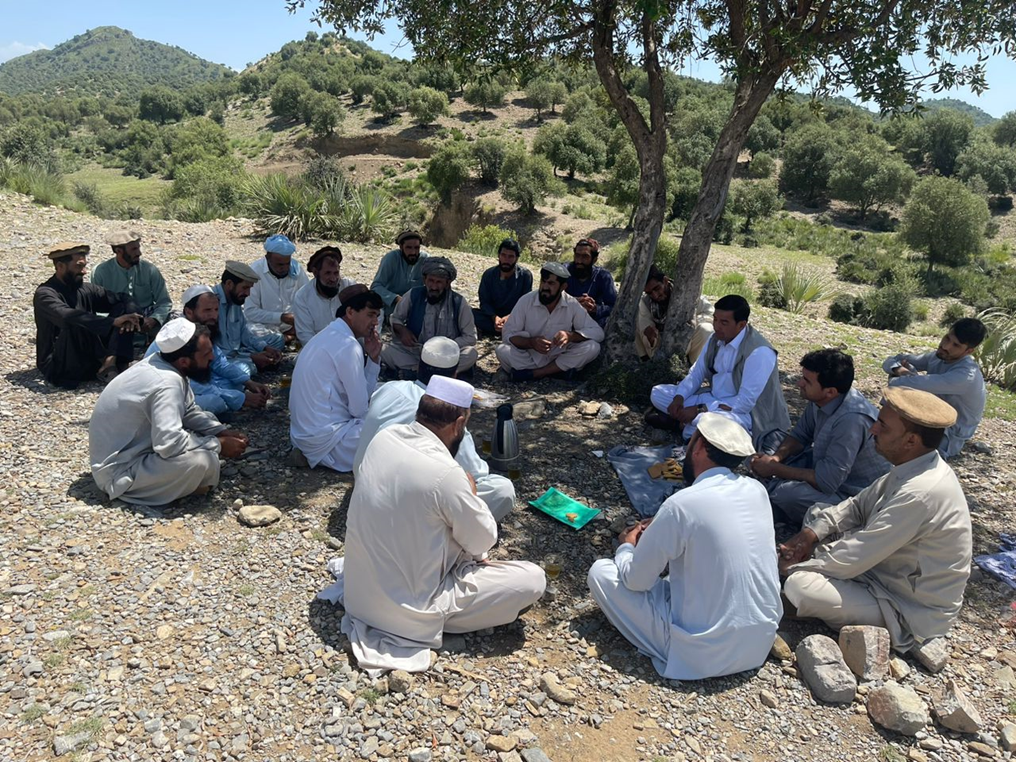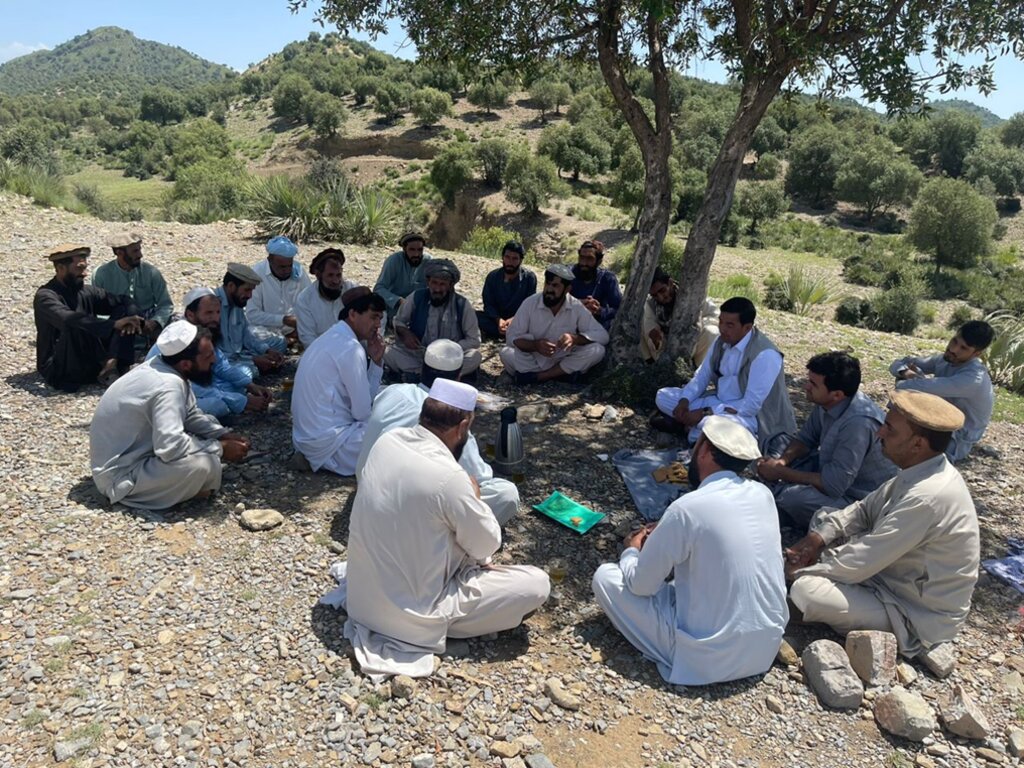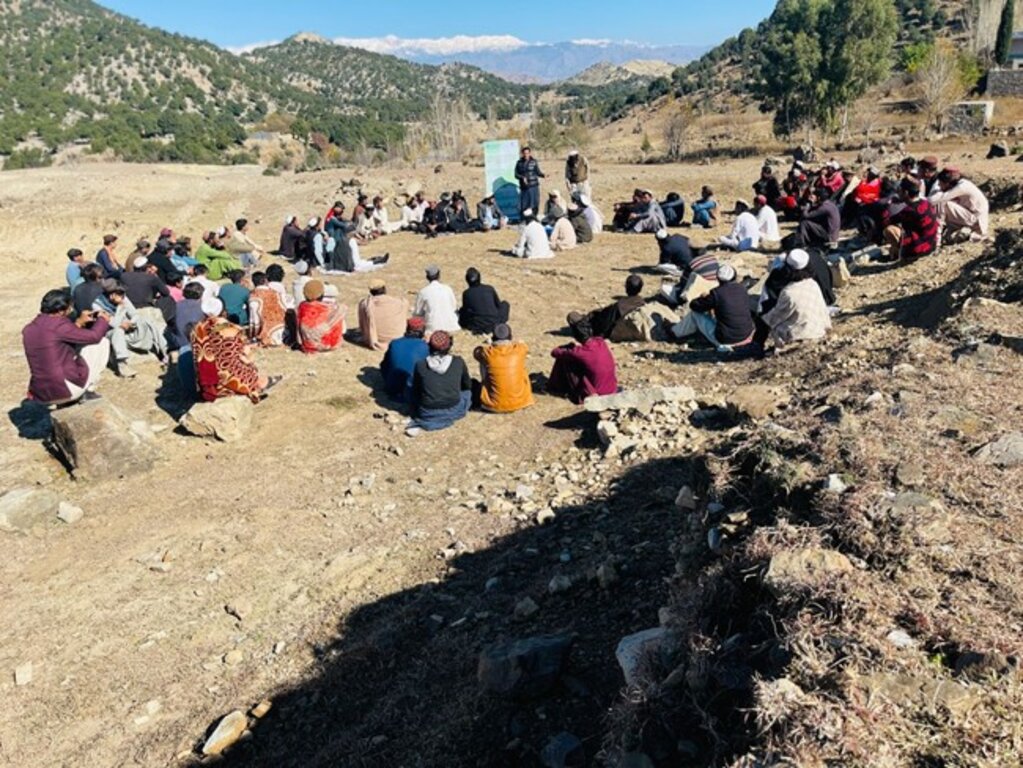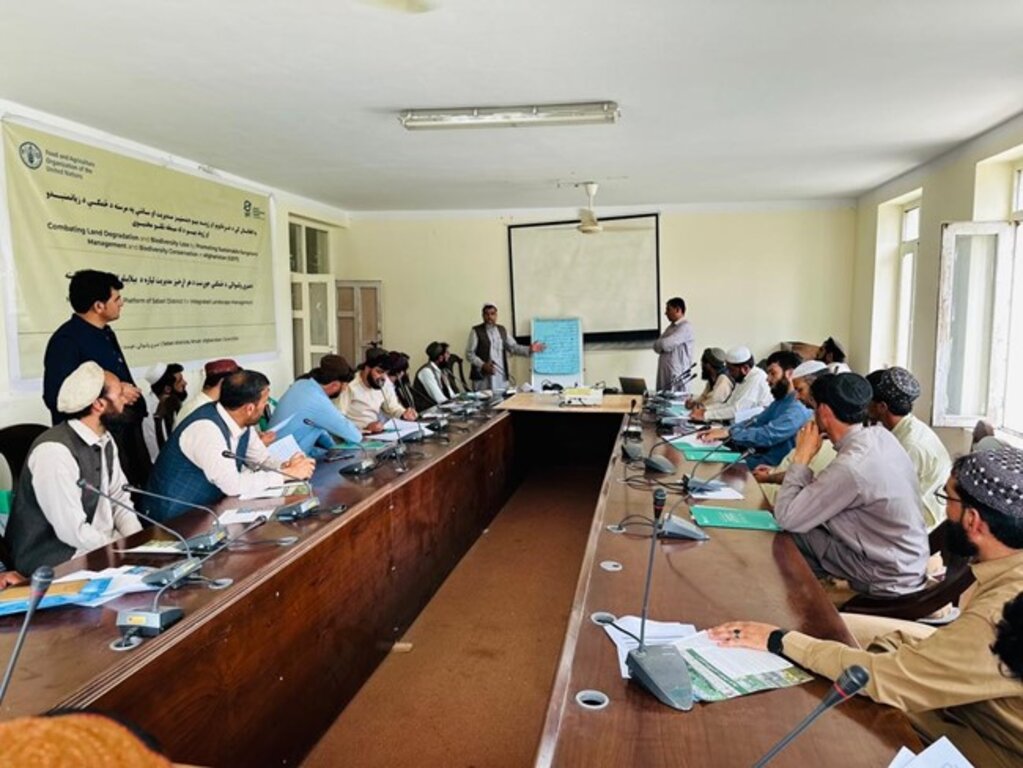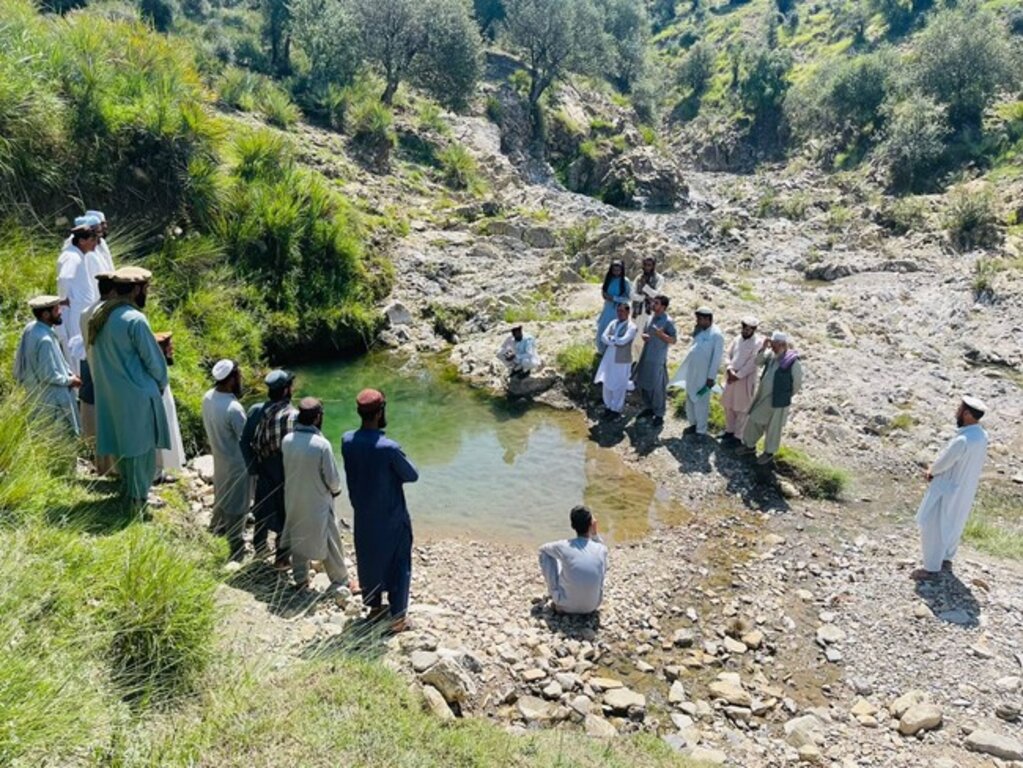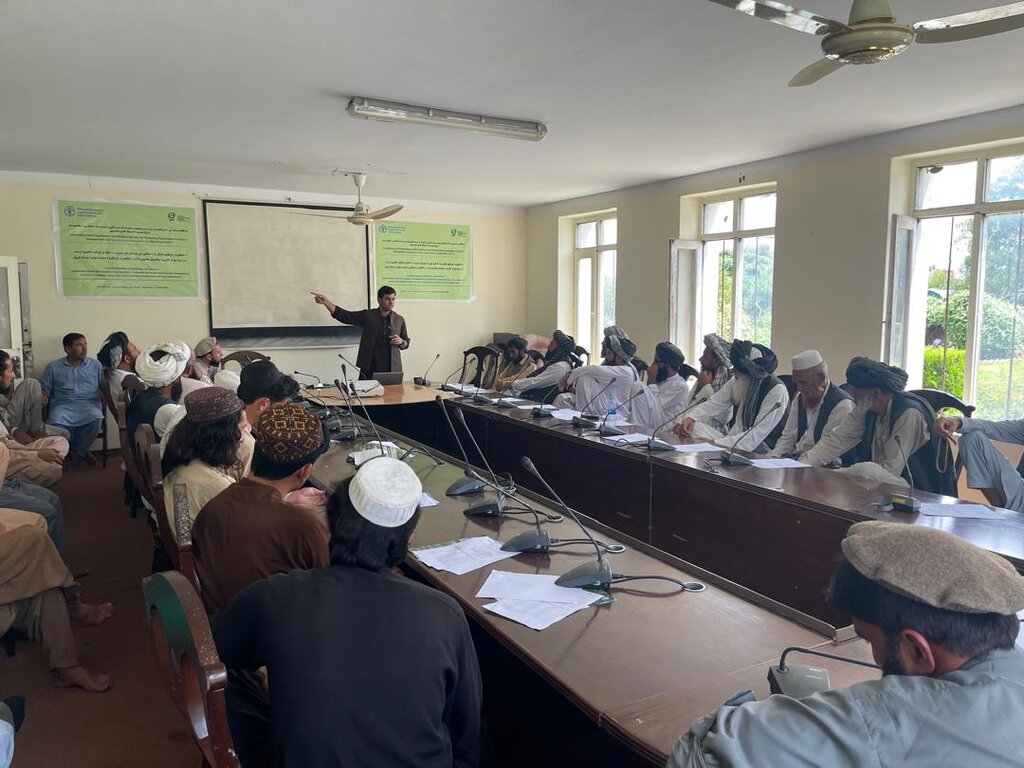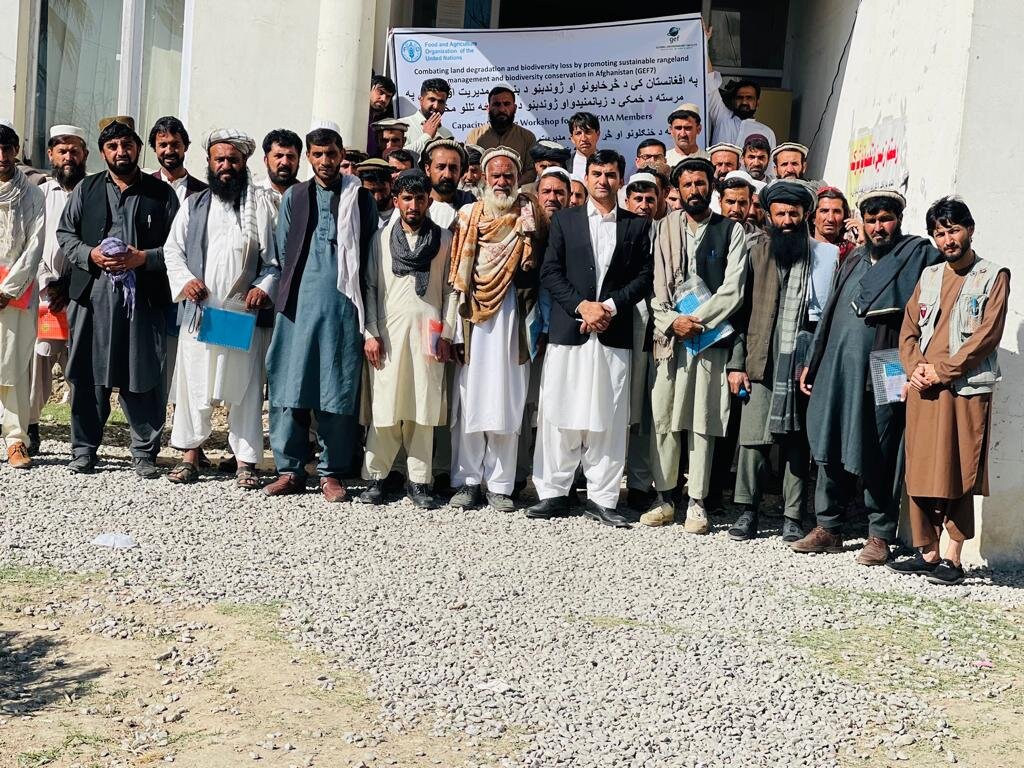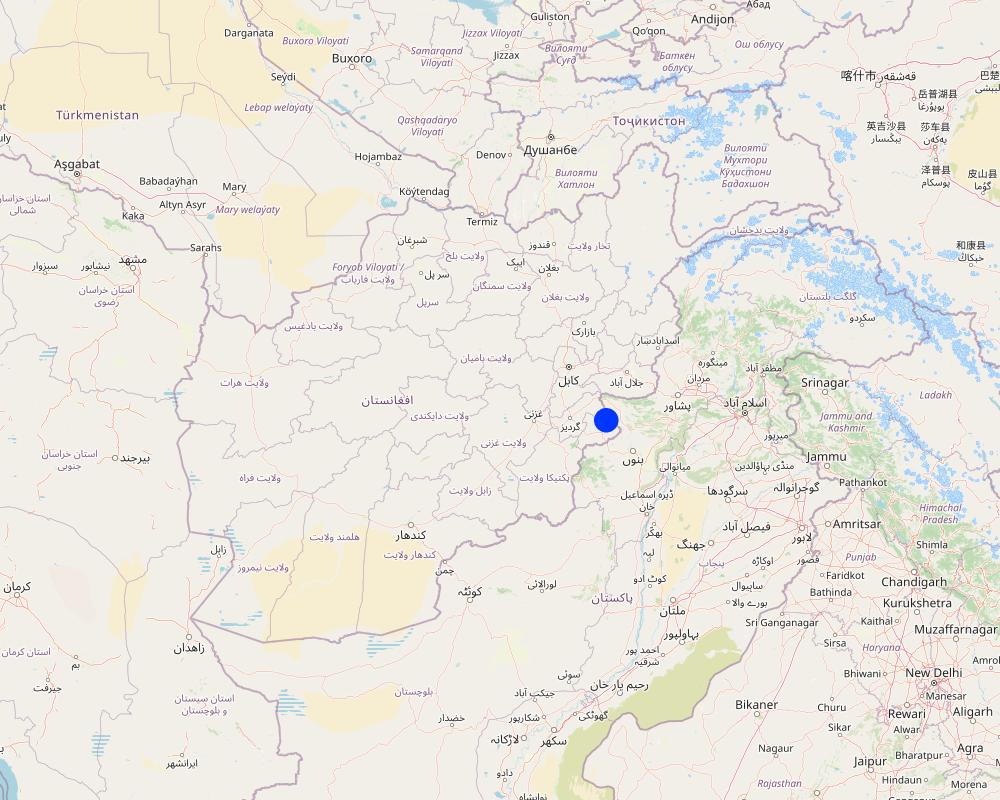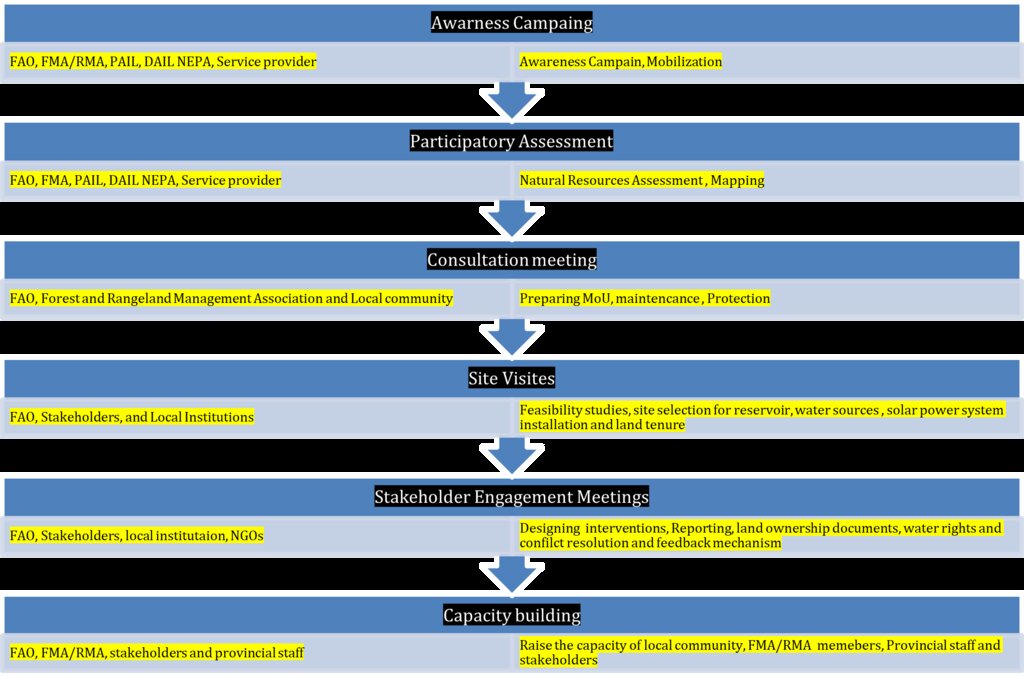Stakeholder collaboration for building Learning Site for landscape restoration [阿富汗]
- 创建:
- 更新:
- 编制者: Mohammad Arif
- 编辑者: Afghanistan Safi, Megha bajaj, Mohammad Aslam Hasand
- 审查者: Rima Mekdaschi Studer, Illias Animon, Muhammad Ishaq Safi
دځمکې مخینی د بیارغونې په موخه دښکیلو اړخونو د ګډو هڅو سره د زده کړی ساحی رامینځ ته کول
approaches_7469 - 阿富汗
查看章节
全部展开 全部收起1. 一般信息
1.2 参与方法评估和文件编制的资源人员和机构的联系方式
土地使用者:
Muhajir Akbar
+93(0) 797166519
Sparkai Forest and Rangeland Management Association
Stara Mila- Sparkai village- Baak district - Khost-Afghanistan
阿富汗
有助于对方法进行记录/评估的项目名称(如相关)
Combating land degradation and biodiversity loss by promoting sustainable rangeland management and biodiversity conservation in Afghanistan有助于对方法进行记录/评估的机构名称(如相关)
FAO Afghanistan (FAO Afghanistan) - 阿富汗1.3 关于使用通过WOCAT记录的数据的条件
(现场)数据是什么时候汇编的?:
21/10/2024
编制者和关键资源人员接受有关使用通过WOCAT记录数据的条件。:
是
1.4 SLM技术问卷的参考
2. SLM方法的描述
2.1 该方法的简要说明
To raise awareness and establish a signed Memorandum of Understanding that outlined roles and responsibilities, meetings were held with the local community, FM/RM association, and stakeholders . The FM/RM association also provided a letter of guarantee for the establishment of a learning site focused on forest and rangeland management practices.
2.2 该方法的详细说明
该方法的详细说明:
For Sustainable Land Management (SLM) and biodiversity conservation in Khost, Afghanistan, we started with awareness campaigns in the districts. This mobilization aimed to introduce the project and Community-Based Natural Resource Management (CBNRM) planning, while identifying potential sites for project implementation.
Following the identification of these sites, we launched another awareness campaign to initiate participatory assessments of local natural resources, including forests and rangelands. This led to the development of CBNRM plans, through which we identified gaps in forest and rangeland management that required improvements and new intervention strategies. We also identified the critical issues of forest and rangeland degradation, as well as the needs of the local community, which allowed us to find alternative livelihood interventions to reduce reliance on natural resources.
We visited multiple sites with water availability near forests and rangelands to select the most suitable locations for our interventions.
Once sites were selected, we developed a Memorandum of Understanding (MoU) outlining the roles and responsibilities of each party involved, including FAO, the Forest and Rangeland Management (FM/RM) Association, and the local government. We also prepared a grant letter to ensure the sustainability and ownership of the project by the FM/RM Association.
After the establishment and completion of interventions at the sites, we conducted capacity-building sessions for the local community, FM/RM Association, nomadic groups, and stakeholders from local institutions. These sessions focused on teaching participants how to restore landscapes, specifically forests and rangelands.
The approach includes awareness campaigns, consultation meetings, participatory assessments, resource mobilization, capacity building, and the establishment of a Memorandum of Understanding (MoU) to ensure sustainability. The aim is enabling the local community, FM/RM Association, and stakeholders (Nomads, District and Provincial Agriculture, Irrigation, and Livestock (DAIL/ PAIL),and the National Environmental Protection Agency (NEPA)) to learn good practices for restoring land and forests while utilizing natural resources sustainably. This also involves enhancing the community's capacity to replicate and scale up similar initiatives. The approach is executed through a community-based traditional system, with contributions from both the project team and local communities.
The FM/RM Association has issued a maintenance grantee letter and hired guards to protect the site. Additionally, it is mobilizing villagers and nomads to avoid entering the area and grazing their herds there.
Key stakeholders include PAIL, NEPA, district entities, community institutions, and the FM/RM Association. PAIL and NEPA play crucial roles in helping the local community resolve land disputes and facilitating discussions related to land, water rights, and more. The local community and FMA/RMA are essential to the interventions, contributing to maintenance, safeguarding, dispute resolution over land, grazing management, irrigation, and replacing dead plants. FMA/RM Association serves as key stakeholder established by the project providing legal MoU, maintenance letters, and facilitating awareness and mobilization on-site while addressing any issues that arise during implementation.
Land users appreciate capacity-building sessions during Focus Group discussions and key informant interviews, awareness-raising initiatives, and their involvement in practical implementation. However, they express concerns about cash contributions due to poverty and unemployment, preferring assistance in other forms.
2.3 该方法的照片
2.4 该方法的视频
2.5 采用该方法的国家/地区/地点
国家:
阿富汗
区域/州/省:
Khost
有关地点的进一步说明:
Sparkai Village, Baak district
注释:
The approach was implemented in Sparkai Village and by the Sparkai Forest and Rangeland Management Association in Baak District, Khost Province. An awareness campaign was conducted, alongside coordination meetings with all stakeholders. We visited various villages in the district to carry out a participatory assessment of natural resources and identify key sites for forest, rangeland, and watershed management. After a series of consultation and stakeholder engagement meetings, we selected the site and signed a Memorandum of Understanding (MoU) for the establishment of the learning site.
Map
×2.6 该方法的开始和终止日期
注明开始年份:
2023
若不知道准确的年份,请注明该方法的大致开始日期。:
不到10年前(最近)
终止年份(若不再采用该方法):
2024
注释:
As part of project outputs, a learning site was to be established within the first year, starting in 2022. However, due to the time required for pre-assessment and participatory assessment, as well as community awareness and mobilization efforts, the identification and selection of a suitable site took longer than anticipated. By June 2023, a site was successfully identified namely Stara Mila in Sparkai Village, Baak District, Khost Province. Several key interventions were completed, including the installation of a solar power lifting system, the construction of reservoirs, and the establishment of demonstration areas for restoration. For moving forward, it is essential to sustain and manage these interventions throughout the project's lifespan. The project plans to hand over the management of these facilities to the local community to ensure ownership and long-term sustainability
2.7 方法的类型
- 基于项目/方案
2.8 该方法的主要目的/目标
-Strengthen the skills and knowledge of local communities to effectively adopt solar-powered lift irrigation systems and optimize the use of river resources.
-Enable local communities to sustainably manage and utilize their natural resources, ensuring long-term ecological balance.
-Leverage traditional practices and foster local support to enhance future sustainable natural resource management.
-Actively involve youth in development initiatives, promoting their role in managing natural resources and fostering a sense of stewardship.
-Establish a hub that brings together local communities, stakeholders, and students to learn about land and forest management practices.
-Train local communities and stakeholders on transforming unproductive land into productive agricultural and forest areas, thereby enhancing food security and livelihoods.
-Empower local communities to replicate and put to scale successful land restoration and forest management initiatives, promoting sustainable practices and building community resilience.
2.9 推动或妨碍实施本办法所适用的技术的条件
社会/文化/宗教规范和价值观
- 启动
Foster social participation by promoting women's involvement in decision-making processes and integrating traditional mechanisms to enhance community engagement and inclusivity
财务资源和服务的可用性/可得性
- 阻碍
Local communities involved in forest and rangeland management often face significant challenges due to a lack of financial resources. Unemployment, political crises, and traditional norms can further restrict their access to essential funding and services. These barriers hinder their ability to implement sustainable management practices and improve their livelihoods.
机构设置
- 启动
Forest and Rangeland Management Association (FM/RM A) established
参与者的的协作/协调
- 启动
FM/RM A is key stakeholders in Community-Based Natural Resource Management (CBNRM) activities. Local communities and stakeholders regularly hold coordination meetings to collaborate and contribute to various development projects.
法律框架(土地使用权、土地和水使用权)
- 启动
FMA/RM A serves as a legal entity responsible for managing land tenure and water rights through traditional practices, with support and contributions from government entities.
土地治理(决策、实施和执行)
- 启动
FMA/RM A and local communities are actively participating in decision-making processes related to land management. Their involvement includes supervision, monitoring, resolving land disputes, implementing policies, and addressing various land-related issues. This collaborative approach ensures that the voices of local stakeholders are heard and considered in all aspects of land governance..
了解SLM,获得技术支持
- 启动
Local community, FMA/RM A and stakeholders have access to knowledge, skills about SLM and sustainable forest and rangeland management practices.
工作量、人力资源可用性
- 启动
This technology has created jobs and provided sufficient manpower to facilitate the implementation of CBNRM interventions.
3. 相关利益相关者的参与和角色
3.1 该方法涉及的利益相关者及其职责
- 社区组织
The Forest and Rangeland Management (FM/RM) Association .
FM/RM Association facilitated awareness campaigns, mobilized communities, conducted participatory assessments, and resolved land and water disputes.
- SLM专家/农业顾问
FAO SLM specialists, community mobilizers, local volunteers and district level Agriculture Irrigation and Livestock workers, National Environmental Protection officer were the stakeholders.
To enhance the roles of stakeholders involved in coordinating forest and rangeland management at district-level, the following should be considered: capacity building, organizing workshops and seminars, facilitating knowledge sharing, improving communication, establishing feedback mechanisms, and fostering community engagement.
- 地方政府
Provincial Agriculture, Irrigation, and Livestock (PAIL), the National Environmental Protection Agency (NEPA) were involved at provincial level.
To improve the roles of stakeholders involved at provincial level in coordination of forest and rangeland management, the following should be considered: conflict resolution mechanism, collaborative partnerships and monitoring and evaluation and the utilization and sustainability of the technology.
- 国家政府(规划者、决策者)
District governor and District Urban Development and Land
Facilitated meetings on natural resource management laws and conflict resolution
如果涉及多个利益相关者,请注明领导机构:
FAO-Afghanistan
3.2 当地土地使用者/当地社区参与该方法的不同阶段
| 当地土地使用者/当地社区的参与 | 指定参与人员并描述活动 | |
|---|---|---|
| 启动/动机 | 自我动员 | Local land users FM/RM Association members called for awareness raising campaigns, mobilization, resolving disputes over the land, participating in participatory assessment, feasibility studies, site identification and site selection. |
| 计划 | 互动 | Local community provided first hand data about the natural resources, indigenous species, for the CBNRM planning |
| 实施 | 互动 | The FM/RM Association actively engaged in the implementation process by hiring guards for site security, monitoring activities, and providing human resources for interventions. This collaborative approach ensured effective oversight and community involvement. |
| 监测/评估 | 互动 | Local community and stakeholders supervised and monitored the learning site throughout the implementation and up to completion. They provided a guaranteed letter ensuring the sustainability and ongoing maintenance of the learning site. |
3.3 流程图(如可用)
具体说明:
The project involved various stakeholders, including the FM/RM Association, Provincial and District Agriculture, Irrigation and Livestock (PAIL/DAIL) departments, the National Environmental Protection Agency (NEPA), and service providers. These organizations participated in awareness campaigns, consultation meetings, participatory assessments, feasibility studies, and site selection.
The FAO technical engineering team designed the solar-powered lifting system and reservoirs, which were implemented through a service provider. Additionally, the FAO team selected forest species for reforestation and demonstration plots. The community, along with the FM/RM association, planted the provided saplings from FAO.
Demonstration plots were prepared, and fencing was installed through a contract with a service provider. The local community and FMA/RMA hired a guard to ensure the site's safety and maintenance.
Key stakeholders, including PAIL, DAIL, NEPA, and district entities, played important roles in meetings, dispute resolution, and providing assistance in accordance with their policies and responsibilities.
3.4 有关SLM技术选择的决策
具体说明谁有权决定选择要实施的技术:
- 所有相关参与者,作为参与式方法的一部分
解释:
All activities, from awareness campaigns to mobilization coordination, participatory assessments, feasibility studies, and decision-making processes, were carried out collaboratively. Every stakeholder actively engaged from the selection phase through implementation to successful completion.
明确做出决策的依据:
- 对充分记录的SLM知识进行评估(基于证据的决策)
4. 技术支持、能力建设和知识管理
4.1 能力建设/培训
是否为土地使用者/其他利益相关者提供培训?:
是
明确受训人员:
- 土地使用者
- 现场工作人员/顾问
培训形式:
- 在职
- 农民对农民
- 示范区域
- 公开会议
涵盖的主题:
Sustainable forest and rangeland management, rotational grazing, integrated landscape management, CBNRM planning, biodiversity conservation, demo plots preparation, reforestation, watershed management climate smart agriculture, pastoralist field school, operation and maintenance of the learning site.
注释:
During the project's initiation, the FAO-GEF7 team conducted comprehensive training sessions for a diverse range of participants, including the local community, forest and rangeland management associations, stakeholders, Kuchies (nomads), youths, and women. These training sessions were designed to cover a broad range of topics essential for sustainable resource management and community engagement.
Participants were introduced to the project's objectives, fundamental principles of Natural Resource Management (NRM), Community-Based Natural Resource Management (CBNRM) planning, the establishment of community-based nurseries, mechanisms for receiving and addressing complaints, sustainable practices for managing forests and rangelands, reforestation methods, watershed management strategies, value chains within forest and rangeland ecosystems, integrated landscape management approaches, techniques for biodiversity conservation, measures for controlling grazing activities, practices for rotational grazing, management of demonstration plots, principles of climate-smart agriculture, pastoralist field schools, and the operation and maintenance of the learning site.
Through these training sessions, the project aimed to equip participants with the knowledge and skills necessary to promote sustainable practices, enhance biodiversity conservation, foster community engagement, and ensure the long-term success of the project's objectives.
4.2 咨询服务
土地使用者有权使用咨询服务吗?:
是
指明是否提供了咨询服务:
- 在土地使用者的土地上
- At learning site established by local volunteers, District Agriculture Irrigation and Livestock (DAIL) staff and FAO technical team
说明/注释:
The FAO technical team collaborates with on-site local volunteers in villages, district agriculture, irrigation, and livestock departments, along with Forest and Rangeland Management Associations, to offer crucial advisory services. These services encompass irrigation techniques, maintenance practices, plantation guidance, establishment of demonstration plots, grazing management strategies, reforestation efforts, implementation of rotational grazing methods, mulching practices, as well as land and forest restoration techniques
4.3 机构强化(组织发展)
是否通过这种方法建立或加强了机构?:
- 是,适度
具体说明机构的强化或建立程度:
- 本地
说明机构、角色和职责、成员等。:
The Forest and Rangeland Management (FM/RM) Association, in collaboration with the local community, plays a pivotal role in the sustainable management of natural resources. They serve as a central institution for coordinating contributions and assistance in various development projects in the area. Their responsibilities encompass mobilization, awareness-raising, participatory assessments, feasibility studies, supervision, maintenance, dispute resolution, and more.
Through a mutually agreed-upon Memorandum of Understanding (MoU), these entities are committed to resolving disputes, providing essential information for data collection, irrigation practices, safeguarding the site, working towards sustainability, maintaining the entire system and site, replacing deceased plants, mobilizing when necessary, controlling grazing activities, promoting the sustainable utilization of natural resources, preparing land for demonstration plots, and establishing forest nurseries.
具体说明支持类型:
- 财务
- 能力建设/培训
- 设备
提供进一步细节:
FAO has supplied saplings, tools, materials, constructed reservoirs and solar power water lifting system and alternative livelihood interventions. They have also conducted capacity-building trainings, on-job trainings, Pastoralist field school trainings, and community engagement for planting saplings. Additionally, they have facilitated on-site activities, mobilization efforts, awareness campaigns, coordination meetings, safeguarding of the forest and rangeland, and encouraged local community involvement. Furthermore, they have actively engaged youths and women in every intervention implementation and have played a vital role in resolving disputes during the implementation process.
4.4 监测和评估
监测和评估是该方法的一部分吗?:
是
注释:
The FM/RM Association, local community members, and the FAO technical team diligently monitored every step of the process from the initiation of the approaches to their completion. They collaboratively conducted site visits to monitor the progress, document their findings, and record observations in both the logbook and KOBO system.
若是,该文件是否用于监测和评估?:
否
4.5 研究
研究是该方法的一部分吗?
否
5. 融资和外部物质支持
5.1 该方法中SLM组成部分的年度预算
如果不知道准确的年度预算,请给出一个范围:
- 2,000-10,000
注释(例如主要的资助来源/主要捐助者):
GEF and Afghan government are funding the project with the applied SLM technologies and approach.
5.2 为土地使用者提供财政/物质支援
土地使用者是否获得实施该技术的财政/物质支持?:
是
如果是,请具体说明支持的类型、条件和提供者:
The FAO provided water pumps, solar panels, pipe fittings, construction of water reservoirs, barbed wire for fencing, saplings for reforestation, seeds for reseeding, as well as training and technical support. The local community has prohibited grazing of the site to ensure long-term sustainability. Additionally, the government will offer support in resolving any conflicts and providing further livelihood interventions.
5.3 对特定投入的补贴(包括劳动力)
- 无
如果土地使用者的劳动力是一项重要的投入,那么是不是:
- 获得其他物质支持
注释:
The FM/RM Association collaborates closely with the local community, both acting as voluntary stewards of the land. Together, they engage in a range of activities, including tree planting, irrigation management, site maintenance, and conservation efforts. In certain instances, FAO provides vital support to the most vulnerable individuals within the community. Notably, FAO offers alternative livelihood interventions to enhance economic opportunities and sustainability. These interventions may include the provision of resources such as micro greenhouses, high-quality seeds, equipment for dairy processing, hygiene toolkits, solar cookers, trainings and other necessary materials. By targeting the most vulnerable members of the community, including women, the association aims to empower them and encourage their active participation in various development initiatives. This holistic approach not only fosters environmental stewardship but also promotes social inclusion and economic resilience within the community. Through collaborative efforts and targeted support, the association and the local community work hand in hand to create a more sustainable and equitable future for all stakeholders involved.
5.4 信用
是否根据SLM活动的方法给予信用值?:
否
5.5 其它激励或手段
是否有其他激励措施或工具用于促进SLM技术的实施?:
是
如果是,请具体说明:
FAO offered field visits, training, and small-scale income-generating interventions to enhance household food security and support alternative livelihoods for land users and local communities.
6. 影响分析和结论性陈述
6.1 方法的影响
该方法是否有助于当地土地使用者,提高利益相关者的参与度?:
- 否
- 是,很少
- 是,中等
- 是,支持力度很大
FAO has supported various interventions, including the construction of reservoirs, installation of solar-powered water lifting systems, and provision of seeds and saplings for reforestation, along with exploring alternative livelihood opportunities. A key element of these interventions is the active participation of local land users in decision-making processes and their empowerment to drive sustainable outcomes.
这种方法是否有助于基于证据的决策?:
- 否
- 是,很少
- 是,中等
- 是,支持力度很大
Evidence-based decision-making was facilitated by involving participatory assessments, site selection, preparation of demonstration plots, and sapling planting. This hands-on, inclusive approach allowed for data collection and analysis ensuring that decisions were knowledge-based.
该方法是否帮助土地使用者实施和维护SLM技术?:
- 否
- 是,很少
- 是,中等
- 是,支持力度很大
Capacity building and training sessions, awareness-raising radio messages broadcasted on land and forest management, brochures and manuals supported a comprehensive outreach strategy.
该方法是否提高了SLM的协调性和成本效益?:
- 否
- 是,很少
- 是,中等
- 是,支持力度很大
Conducted regular mobilization efforts, established Forest and Rangeland Management Association facilitated a coordination platform involving local community and government entities. Signed a Memorandum of Understanding (MoU) outlining roles and responsibilities for technology implementation and ensuring sustainability.
该方法是否调动/改善了使用财务资源实施SLM的途径?:
- 否
- 是,很少
- 是,中等
- 是,支持力度很大
The recently established Forest and Rangeland Management Association requires increased advocacy to gain recognition among NGOs, donors, and government entities. It serves as a focal point in the area for coordinating development projects, with a dedicated social fund for maintenance. They are actively seeking support from NGOs and other organizations to secure funding for these impactful initiatives.
该方法是否提高了土地使用者实施土地管理的知识和能力?:
- 否
- 是,很少
- 是,中等
- 是,支持力度很大
The establishment of a learning site for Sustainable Land Management (SLM) practices has significantly enhanced community capacity. Residents have acquired knowledge and skills enabling them to implement various SLM technologies including reforestation, afforestation, and improved land management practices for effective land restoration.
该方法是否提高了其他利益相关者的知识和能力?:
- 否
- 是,很少
- 是,中等
- 是,支持力度很大
With access to the Sustainable Land Management (SLM) learning site, the local community and government have enhanced their capacities. Regular visits to the site enable them to exchange knowledge, skills, and experiences, fostering continuous improvement and collaboration for future advancements in land management practices.
该方法是否建立/加强了机构、利益相关者之间的合作?:
- 否
- 是,很少
- 是,中等
- 是,支持力度很大
Establishing Forest and Rangeland Management has fostered sub-coordination meetings and joint training sessions among local communities, government departments, DAIL and NEPA near forest and rangeland areas. This collaboration strengthens partnerships, enhancing sustainable land and resource management practices in the province.
该方法是否缓解了冲突?:
- 否
- 是,很少
- 是,中等
- 是,支持力度很大
Registered with the government and traditional bodies, the FMA/RMA from the local community has successfully resolved numerous conflicts and continues to address issues through established mechanisms.
该方法是否有助于社会和经济弱势群体?:
- 否
- 是,很少
- 是,中等
- 是,支持力度很大
Collaborative efforts have provided vulnerable community groups with access to alternative livelihood interventions and a platform to voice their needs for assistance and rights regarding natural resources.
该方法是否改善了性别平等并赋予女性权力?:
- 否
- 是,很少
- 是,中等
- 是,支持力度很大
Gender inclusion is prioritized across all interventions, particularly in alternative livelihood programs aimed at household income generation and enhancing food security
该方法是否鼓励年轻人/下一代土地使用者参与SLM?:
- 否
- 是,很少
- 是,中等
- 是,支持力度很大
Conducted an awareness campaign in nearby schools, educating students and distributing informative brochures.
该方法是否改善了阻碍SLM技术实施的土地使用权/用户权问题?:
- 否
- 是,很少
- 是,中等
- 是,支持力度很大
The established Forest and Rangeland Management Association, formal bodies elected by the local community, are resolving land tenure issues and rights for implementing Sustainable Land Management (SLM) technologies
该方法是否带来了更可持续的能源使用?:
- 否
- 是,很少
- 是,中等
- 是,支持力度很大
Through the Forest and Rangeland Management Association initiative, the local community has acquired essential knowledge to utilize their natural resources sustainably, including using solar panels for lifting of water to irrigate reforested land
该方法是否提高了土地使用者适应气候变化/极端情况和减轻气候相关灾害的能力?:
- 否
- 是,很少
- 是,中等
- 是,支持力度很大
The local community and land users have learned to implement flood control measures, prevent deforestation, regulate grazing and fires in the forest, and enhance water table recharge through practices that improve the vegetation cover.
该方法是否会带来就业、收入机会?:
- 否
- 是,很少
- 是,中等
- 是,支持力度很大
Initiated short-term employment opportunities with the potential for significant expansion through ongoing initiatives.
6.2 土地使用者实施SLM的主要动机
- 增加生产
This initiative has led to an increase in improved pastureland for livestock, ensuring sustainable income generation for households in the community.
- 减少土地退化
The local community has learned various practices implemented at the learning site and is now applying these techniques to their degraded land. They have adopted rotational grazing and controlled grazing methods, as well as planting cuttings along riverbanks. These efforts have significantly reduced land degradation.
- 降低灾害风险
The implementation of various technologies has led to a notable decrease in floods, landslides, fires, and droughts within the region.
- 规章制度(罚款)/执行
The local communities, along with the established Forest and Rangeland Management Associations from several villages, serve as the executive bodies for natural resource management. Each community consults the FM/RM Association for decision-making roles and has developed its own regulations for managing natural resources and the learning site.
- 加入运动/项目/团体/网络
The establishment of the FM/RM Association and the learning site has facilitated the formation of a cohesive group and network comprising various stakeholders. This platform enables learning and collaboration on sustainable land management practices, particularly focusing on forest and rangeland restoration.
- 环境意识
The local community, students, and stakeholders have acquired crucial knowledge in environmental safeguarding, sustainable utilization, and restoration practices.
- 提高SLM知识和技能
By establishing a learning site focused on sustainable land and forest management practices, the FM/RM association has actively engaged various stakeholders and the local community. Through these interactions, knowledge and skills vital for the sustainable management of land and forests have been significantly enhanced.
- 冲突缓解
The FM/RM association stands as a formal institution within our local community, dedicated to addressing conflicts concerning land and natural resources. Through their efforts, conflicts are being effectively resolved, ensuring that the rights of all parties involved are duly considered and upheld.
6.3 方法活动的可持续性
土地使用者能否维持通过该方法实施的措施(无外部支持的情况下)?:
- 是
若是,请说明如何维持:
As we strive to combat land degradation, enhance resilience within the local community, and conserve biodiversity, the system has been entrusted to the FMA/RM Association and the local community. This collaborative approach is designed to ensure long-term sustainability, enabling the community to effectively utilize, maintain, and eventually pass on the system to future generations...
6.4 该方法的长处/优点
| 土地使用者眼中的长处/优势/机会 |
|---|
| The FM/RM Associaion of the local community functions as an executive body dedicated to effective management of natural resources. It has established itself as a strong institution, collaborating closely with various stakeholders to ensure sustainable development for future projects. This proactive approach enhances community engagement and promotes responsible stewardship of local resources. |
| Conducting awareness campaigns through in-person events and radio broadcasts on forest, rangeland management, and biodiversity conservation is vital to encourage the local community to utilize natural resources sustainably. |
| Involving the local community in consultations and decision-making fosters a sense of ownership, encouraging sustainable system utilization. |
| Involving youth in FMA/RM Association and decision-making empowers them as future leaders representing the local community in development activities. This ensures that future generations can learn sustainable land and forest management practices. |
| 编制者或其他关键资源人员认为的长处/优势/机会 |
|---|
| Working closely with the community is essential due to the presence of potential land disputes, indigenous knowledge, and decades of information that can provide significant advantages for any natural resources management efforts. |
| Uniting the local community and establishing an official Forest and Rangeland Management Association as a platform can significantly enhance the smooth implementation of projects and ensure the long-lasting sustainability of the system. |
| Awareness campaigns, mobilization, consultation, capacity building, and the creation of Memorandums of Understanding (MoU) that outline roles and responsibilities are essential elements of Sustainable Land Management (SLM) approaches. These components are crucial for effectively transferring the management of the system to local communities, enabling them to sustainably utilize the land over time. |
| It serves as an educational center where the younger generation can visit to acquire knowledge on natural resource management, biodiversity conservation, combating land degradation, and grazing management. This exposure can inspire them to actively engage in development projects and revive traditional systems to conserve forests and rangelands for sustainable use. |
6.5 该方法的弱点/缺点以及克服它们的方法
| 土地使用者认为的弱点/缺点/风险 | 如何克服它们? |
|---|---|
| We face several challenges, including land tenure issues, land disputes, and water rights. These problems often remain unresolved due to nepotism and poverty, with influential individuals in government hindering progress. Additionally, traditional mechanisms for conflict resolution are sometimes overlooked by the government, complicating efforts to address these critical issues. | We need to prioritize advocacy and lobbying efforts, as well as increase the frequency of sub-coordination meetings with the government. This will help establish formal institutions within our community and ensure that our decisions are respected in all circumstances. |
| The challenges of controlling Kuchies settlement and overgrazing are exacerbated by insufficient support from neighboring villages, districts, and government authorities. | To address this issue, it is essential to establish collaborative initiatives that encourage sustainable land management practices, promote community engagement, and foster partnerships among stakeholders. By developing comprehensive support systems, we can effectively mitigate overgrazing and ensure the sustainable use of natural resources. |
| The FMA/RM Associaton is not widely recognized among stakeholders. As a result, it is challenging for NGOs and donors to effectively coordinate with them for consultations and needs assessments. | To enhance recognition of FMA/RM Association among stakeholders, we should conduct workshops and seminars that highlight their roles and benefits. Establishing a dedicated platform for NGOs and donors will facilitate ongoing dialogue and information sharing. Actively engaging stakeholders in joint assessments will help identify community needs while ensuring FMA/RMA is included in discussions. Additionally, fostering partnerships with local government and other organizations will increase visibility and support for these initiatives. |
| The absence of youth committees and the weakening of local traditional systems pose significant challenges for future projects. | We should actively involve youth by forming committees and strengthening the local traditional system. Additionally, we can assist the community in documenting these mechanisms formally to ensure they are preserved for future reference. |
| 编制者或其他关键资源人员认为的弱点/缺点/风险 | 如何克服它们? |
|---|---|
| The local community lacks sufficient knowledge about indigenous plants and natural resources. | We should establish indigenous demonstration plots and create a comprehensive database to record all relevant data. Additionally, it is important to develop a proper mechanism for data collection to ensure valuable information is preserved for future generations. |
| The lack of knowledge and high illiteracy rates are major issues, compounded by the absence of a proper curriculum in schools that addresses indigenous knowledge and natural resources in the country. | We need to enhance the capacity of local communities regarding indigenous plant resources by developing a curriculum to be taught in schools for the younger generation. Additionally, increasing field visits will help students and community members gain firsthand knowledge of their local resources. |
| The lack of an effective grazing management mechanism has led to conflicts among nomadic communities and Kuchies (Nomads) with little attention from the government or local organizations. | The PAIL departments, along with NEPA, district entities, FMA/RM A,ssociation and academic departments, should collaborate to develop an effective mechanism for grazing management and rangeland restoration. |
| The lack of knowledge regarding the maintenance of solar-powered lifting systems, coupled with insufficient technical skills for troubleshooting and repairs, poses significant challenges. | We should provide training to the local community on how to operate the solar-powered lifting systems and offer guidance on troubleshooting and repairs. Additionally, we can connect them with mechanics for further hands-on training. |
7. 参考和链接
7.1 方法/信息来源
- 实地考察、实地调查
6
- 与土地使用者的访谈
20
- 与SLM专业人员/专家的访谈
4
7.2 参考可用出版物
标题、作者、年份、ISBN:
N/A
7.3 链接到网络上可用的相关信息
标题/说明:
N/A
链接和模块
全部展开 全部收起链接
无链接
模块
无模块


